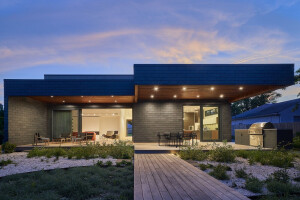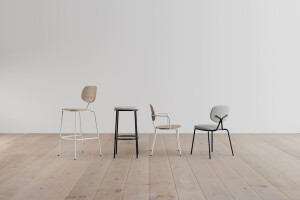On a beautiful sloping plot facing south, surrounded by natural low mountain vegetation, right at the beginning of the Sierra de Guadarrama, a couple living abroad decided to build a house to settle in Spain. It so happens that both will also be working here. They are dedicated to artistic photography, bind their own books, and develop their photographs, which are generally of a large format. Therefore, they will need spaces with precise conditions of light, humidity, and flexibility to carry out their profession. Thus, we start with an interesting location and a mixed program of residential, work, and exhibition spaces.


As architects, we consider it a great opportunity when we can work directly with the future inhabitants of the spaces we design. If we are commissioned to design a single-family home for the family that will live there, we can act like true tailors, crafting a custom suit. Putting the user at the center of the project is fantastic because we listen to them, understand their personality, concerns, needs, aspirations… and from there, we guide the process toward the creation of a unique building where these people will find total comfort, as everything is tailored to them.

After several conversations with the clients, their extraordinary sensitivity to light stood out. Being professional photographers made them understand light as a poetic and physical material that defines spaces, adds nuances to objects, and changes throughout the day. Light, and of course, shadow in its eternal antagonistic dialogue. How fortunate for an architect to work with clients so interested in light! The project had to start from here.

It was decided to understand the house as an inhabited object capable of interacting with the strong light that bathes these latitudes in central Spain. A piece full of nuances, curves, straight lines, recesses, and protrusions, whose sole purpose is to cast shadows and change throughout the day, playing with the sun.

The materiality of such a building had to be neutral and continuous. The facades, therefore, act like a backdrop, a cinema screen, where light glides and changes. A sober earth-toned coating allows the house to blend well into the natural surroundings, giving the home a monastic, austere appearance, albeit with an unexpected formal richness. It's as if a potter had shaped it using the earth from the ground itself—it is an inhabited vessel.

The interiors follow this intentional material austerity. The large vessel can be explored from within, like termites traveling through their mound, and the project’s intent remains unchanged. Light slides along the curved walls, creating suggestive nuances at every hour, depending on the sun’s tone and intensity. At strategic points, solar chimneys are placed, which, through special systems of mirrors and filters, bring precise light exactly where we want it, such as over the photography lab, the staircase, or the first-floor shower.

By climbing a spiral staircase enclosed by a cylinder, one can access the flat roof of the house, which enjoys extraordinary views of the beautiful surroundings. It is one of the building's most special spots, thanks to the formal interplay created by the solar chimneys and their shadows projected onto the terrace. It is an open-air, dreamlike space dotted with unusual elements, reminiscent of Le Corbusier's rooftops, or even Gaudí’s, where the necessary rigidity of distributing a program among walls finally disappears, and the built volumes can freely enjoy that wise and magnificent interplay under the sun.













































